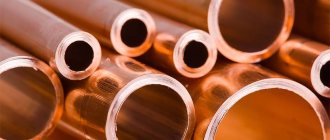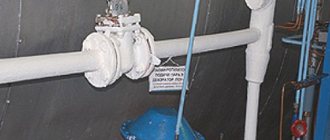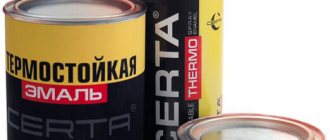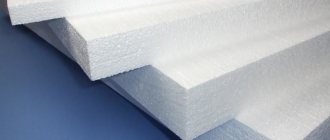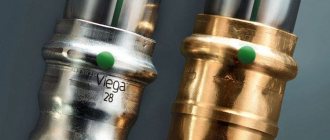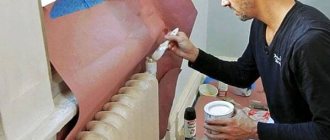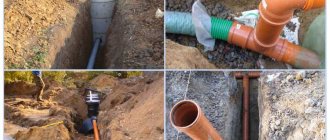Requirements for coloring compositions
Not every paint is suitable for a smooth finish. It must have maximum adhesion, that is, ideally adhere to the surface. Since galvanizing, although to a lesser extent, is also susceptible to corrosion (as evidenced by the appearance of whitish spots on it), it is desirable that the paint contains anti-corrosion components.
Traditional alkyd compositions based on resins that can react with zinc, as well as oil paints, are not suitable for these purposes. They contain not only acids and alkalis, but also some additives that can destroy the galvanized surface. Therefore, paint and varnish materials used for painting must be neutral to zinc.
Paint on galvanized metal intended for exterior use must be frost- and chemical-resistant and resistant to UV rays. Particular attention must be paid to its elasticity - after all, zinc changes dimensions when the temperature changes. Regular paint will crack and peel during use. Naturally, the color should also be selected so that it matches the exterior of the other buildings.
How to paint galvanized steel outdoors to prevent the paint from peeling off
It is important to choose the right way to paint galvanized steel in order to get the best protective barrier and extend the life of the roof. You cannot choose oil paints for this because oxidation will occur upon contact with zinc, and as a result they will not stay on the surface for long.
Types of products for painting galvanized products that are best suited:
- Cyclol. These are acrylic paints with a matte effect, which are made from polymers in organic solvents. High hiding power, resistance to UV rays, adhesion. There is no need to carry out the primer application step for galvanizing in advance.
When choosing paint for zinc, it is important that it is chemically neutral to zinc. Otherwise, it may damage the sheets themselves. It is better to take the galvanizing primer and the paint composition itself of the same brand so that they are definitely compatible, and the result will then be much better.
What requirements must paint compositions meet?
To choose the most suitable paint for external painting of galvanized objects, you need to understand what properties they should have. Below are a number of requirements that you should focus on in order to obtain reliable coverage:
- Obtaining a barrier coating from the harmful effects of the environment, which will make the product more durable;
- Elasticity and good adhesion to the surface;
- Excellent ability to withstand ultraviolet radiation so that the color does not lose its brightness for a long time;
- Hydrophobic properties to withstand water and snow;
- Frost resistance and sudden changes in temperature;
- Fast drying;
- Easy application;
- Safety for nature and human health;
- Decorative.
Selection of composition for coloring
If you don’t know how to paint galvanized steel to prevent it from peeling, use powder compositions containing fine particles and special resins. During the polymerization process, they form a durable coating that adheres well even to smooth surfaces, has good resistance to UV radiation and seasonal temperature changes, and has chemical resistance, impact resistance and elasticity. Such paints and varnishes do not require dilution, as they are sold already in solution. To protect the metal, multiple coatings are not required—a layer 60 microns thick is sufficient.
In addition to powder suspensions, you can use some types of enamel, primers, compositions containing polyester and plastisol, for example:
- “Tsikrol”: roofing primer-enamel, intended specifically for painting galvanized sheets, the composition includes acrylic resins, the solvents are organic compounds such as solvent, ethyl acetate, xylene, butyl acetate; easy to use, has good adhesion; average drying time 18 hours;
- “Serebrol” based on epoxy and perchlorovinyl elastic resins with the addition of aluminum powder that can reflect UV rays, protecting the roof and other structures from overheating; hardens at 20°C for 3 hours; color silver-white;
- “Nerzhalux” enamel based on acrylic copolymers: viscous, adheres well to the surface, wear-resistant, not exposed to acids and alkalis, and has low flammability; can last up to 10 years;
- alkyd enamels, which can also be used as paint for roofs or other structures made of galvanized metal; they adhere well even to smooth surfaces, have good elasticity, frost resistance, and almost do not fade in the sun; however, they cost a lot, so they are rarely used for outdoor work.

To process products used in harsh aggressive environments, special fire-resistant and electrically conductive paints and varnishes intended for application to metal surfaces are used.
ConstructionDialogue
Galvanized iron is one of the most popular building materials; it consists of steel sheets with a thin layer of zinc applied to the surface.
Galvanization is especially often used as a roofing covering, in drainage systems, in the manufacture of chimneys, canopies and cornices.
The zinc coating serves to protect the metal from adverse external influences (precipitation, car exhaust gases, ultraviolet radiation, salts and other negative influences), extending the service life of metal structures, which are mainly used in the open air, constantly exposed to negative environmental influences.
But the zinc layer is also subject to corrosion, although much less than steel.
Over time, “white rust” appears on the surface - a porous white coating through which moisture and oxygen begin to easily penetrate to the steel sheet, so galvanizing itself needs additional protection.
The most effective and simple solution is to apply painting compounds. Let's consider whether it is possible to paint galvanized iron and what is the best way to do it.
Dyeing technology
Experts recommend painting galvanized steel a year after the start of use, when the oxidation products have completely disappeared and a durable patina film appears on the surface. Plus, during this time the coating will become slightly rough - the paint will stick much better. If painting is done immediately after purchase, it is advisable to pre-treat the surface of the sheets with abrasives.
- To protect against corrosion during storage, manufacturers coat metal sheets with a layer of mineral oil. It must be dissolved with ammonia water.
- The old layer of paint and traces of corrosion are cleaned off with fine abrasive sandpaper or a wire brush. Be careful not to damage the coating. For large volumes, sandblasting is used.
- The surface must be clean and dry. This is especially true for alkyd enamel. If it gets exposed to dust or moisture, it will begin to peel off after drying.
- To degrease and remove salt stains, the metal is washed with a soap or alkaline solution and then dried well.
- Before coating with paints and varnishes, it is recommended to treat the surface with a primer. This will not only save paint, but also enhance adhesion. It is selected according to a color similar to the color of the paint and varnish composition.
- If necessary, solvents are introduced into it. Their types are always indicated in the manufacturer's instructions.
- Apply the paint in a thin layer using special sprayers. Small areas can be treated with a brush or roller.
- When applying subsequent layers, the surface should be thoroughly dried.
So, we have described in detail how to paint galvanized steel so that it does not peel off. For these purposes, special compounds with high adhesion are used that are resistant to aggressive environments and temperature changes. The industry offers a sufficient selection of colors of such paint and varnish compositions that have a long service life, from which you can choose the appropriate ones.
Source: kraskaok.ru
How to paint galvanized steel - how to choose and apply the composition correctly
Many people do not understand why paint zinc-coated steel, since it is already very reliable and durable. However, during use there is often a need for additional protection, and the aesthetic appearance of such a coating is not very attractive. Let's look at how to paint galvanized steel and how to do it in accordance with the technology.
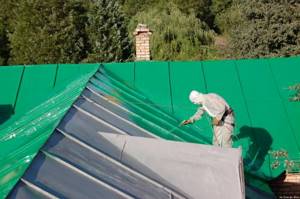
In the photo: painting not only protects the surface, but also significantly improves the appearance
About the need to paint pipes
Steel water and gas pipes (VGP systems) can be galvanized or ordinary, that is, not protected from rust. In cold water supply systems, you can use products that are protected not only from the outside, but also from the inside. Products containing zinc inside cannot be used in hot water supply systems, since zinc peeling occurs already at a temperature of 60˚C.
Why is it necessary to additionally protect metal that already has protection by painting? Only because this protection is unreliable. There is no consensus among experts regarding the painting of galvanized products located in residential premises. For example, the customer and the contractor have opposite opinions about whether painting of such products is necessary. Therefore, if we are talking about a private household or an apartment in a high-rise building, then the owner must solve this problem.
You can clean galvanized steel from grease and oil contaminants using the detergent and inhibitory agent “FAS-104”, which contains neither acids nor alkalis.
In reality, a thin layer of zinc, for example, on the roof of a house covered with galvanized iron, begins to rust under the influence of the environment. Only this kind of rust is called white. Such iron on the roof is painted with paints specially made for this purpose. Anti-corrosion paint tsikrol is used for painting metal used in open atmosphere conditions.
Stainless steel paint, together with phosphorus primer, is used to paint the same metal working in an aggressive atmosphere. In this case, one layer of primer must be covered with three layers of paint. Hence the conclusion: it is necessary to protect the galvanized surface in a certain operating environment.
Should this be done in an apartment? There is no special need. It is enough to protect the welded areas from rust, but it is probably not worth painting the entire surface. VGP systems can be painted only to hide the dull gray color against the background of the walls of the kitchen or bathroom, where the pipes are usually located. That is, if you paint them, then only for aesthetic reasons.
Indeed, the color of the walls in the apartment does not harmonize with the gray color of zinc. If VGP systems are painted in a color that matches the color scheme of the walls, then it will become invisible.
To paint pipes in an apartment, you must not only choose a paint that will last a long time on the galvanized surface, but its color must also match the style of the room.
LLC DESIGN PRESTIGE
Main stages of work
So, when carrying out work with your own hands, you need to carry out all activities in a certain sequence. This will simplify the whole process, because you will know exactly what to do and why.
Paint selection
A very important stage, since not every composition is suitable for the job.
As a rule, in trading you can find the following options:
- Most often, special galvanized roofing paints are used. They are highly resistant to weathering and give the surface a water-repellent effect; most often the composition is based on acrylic resins. The packaging should specifically indicate that the composition is suitable for zinc coatings; you should not take the seller’s word for it, since it is unlikely that he himself painted such materials.
Roofing paints are sold in large containers
- If materials are exposed to aggressive influences, it is better to treat them with more durable compounds. These include alkyd-urethane coatings, which are very reliable, but their cost is also higher. Do not forget that the instructions on the package must be studied before use, this will avoid problems during operation.
Alkyd-urethane composition has high performance properties
- If you have galvanized structures that need to be additionally protected from fire in case of a fire, then you need fire-retardant metal paints Polistil; there are other manufacturers, but this product has a reasonable cost and has proven itself well among specialists. The difference between these compositions is their ability to bubble under the influence of fire and create a protective coating that increases the strength of the structure.
Polistil paint will greatly increase the fire resistance of structures
- Another option is Zinga conductive paint. This is a one-component composition that consists of 96% zinc, which gives it the highest anti-corrosion properties. This is a kind of analogue of factory hot-dip galvanizing, the work is quite simple, so you will not have any difficulties, the paint is expensive, so it should be used only where the highest degree of protection is required.
This composition is one of the most reliable, but its cost is appropriate
A very common question is: how to paint a galvanized pipe? Let us note right away that if it is heated to high temperatures, it is unlikely that any composition will be durable. But if the temperature is low or the pipes are part of the ventilation system, then they are painted with the same paints as sheet metal.
Remember! All galvanizing paints are intended for outdoor use. Therefore, if you are working inside, do not forget about the need to properly ventilate the room before the paint dries; evaporation of steel compounds is not always harmless.
Surface preparation
A very important stage, since without proper preparation the paint simply will not adhere and will peel off in a short time.
Everything is quite simple here:
- The best preparation is natural aging of the surface. It's very simple: galvanized steel is left for 1 year, exposed to temperature changes, humidity and other factors, causing the surface to become rougher, which improves adhesion. In addition, inhibitors that impair paint adhesion are washed off from the material.
- If a powdery coating (so-called white rust) has formed on the surface, it must be removed, but do not be too zealous so as not to damage it.
- It is best to carry out the treatment with any alkaline solution (even washing powder will do); it will remove dirt and stains from lubricants and other materials.
- The last stage is to wash off the solution with water, it is best to do this with a high-pressure apparatus - it will wash away both the dirt and the cleaning solution.
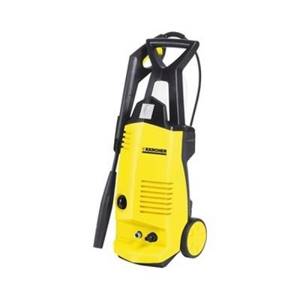
For work on the roof, it is better to choose a lightweight and compact washing option.
Painting works
Everything is quite simple here:
- If the paint does not contain primer, the surface is treated with a special primer. You can continue work only after it has dried.
- Painting is carried out from the ridge along the slope. Work can be carried out in different ways: with a brush, roller or spray gun (this method is the most economical).
Advice! To avoid slipping, you should walk on the roof in felt boots or shoes with felt heels; this will significantly increase safety when carrying out work.
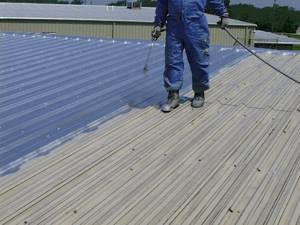
The sprayer makes work quick and easy
Is it necessary to enamel galvanized pipes and what paint to use?

The use of specialized paint for galvanized pipes is not considered mandatory, since the steel is already protected by a zinc coating from the negative effects of atmospheric conditions. The protective layer protects the metal from contact with an aggressive external environment (oxygen and moisture), preventing its corrosion and extending the service life of products made from it.
Dye
When thinking about whether it is necessary to paint galvanized pipes, it is necessary to take into account that the protective zinc coating itself is also subject to corrosion. Over time, a fine white powder appears on the surface of a product coated with a thin layer of zinc, resulting from a chemical reaction of this element with oxygen in the presence of water (moist air).
White rust gradually eats away the protective shell, making the metal vulnerable and shortening the life of the entire heating or water supply system. It is especially important to protect areas of welds from which the zinc has evaporated during welding, as well as threaded joints that have been stripped of the zinc layer during machining.
Types of paints
A galvanized pipe can be properly painted only with specialized dyes that do not contain chemicals that destroy the zinc coating (acids, alkalis, solvents and various aggressive additives). You can paint galvanized steel at home using acrylic, vinyl and alkyd paints.
Paint selection
When choosing a painting material for galvanized products, it is necessary to take into account the features and conditions of their operation. If the pipe product is intended for a chimney or hot water supply (heating) system, then emphasis should be placed on the heat resistance of the paint. For outdoor drainage, it is much more important to consider the ability of the paint coating to resist corrosion.
Imported paints
For painting galvanized parts, the most popular paint compositions are the following brands:
Hammerite paint composition can be applied even to corroded metal products. The resulting coating is resistant to ultraviolet radiation, has high adhesion, excellent anti-corrosion protection, wear resistance and durability. The enamel dries quickly and looks aesthetically pleasing and has a large number of color shades.
But high-quality application is not possible in all ways; when using a roller, small air bubbles may form. The paint layer quickly cracks if degreasing is not carried out thoroughly enough. Rust appears on a painted metal surface within 3-4 years, and salt deposits appear even earlier.
HAMMERITE Instructions for painting metals Tikkurila epoxy paint does not have these disadvantages. It is also a primer and is easy to apply. But it is better to do this in the warm season, since the composition adheres much more strongly to heated galvanized metal.
The coating is resistant to aggressive influences of atmospheric phenomena and chemical environments, withstands heating up to +80°C, while allowing storage and transportation at sub-zero temperatures.
Domestic products
The most popular is Tsikrol acrylic enamel based on an organic solvent; it does not require prior priming of the surface to be treated and is applied in only 1 layer. The color palette is limited to only 5 colors.
The advantages of this material include:
- hiding power;
- resistance to ultraviolet rays;
- high adhesive qualities;
- moisture resistance;
- quick drying;
- high class of anti-corrosion protection.
High-adhesive acrylic one-component enamel Nerzhalux is available in a basic white color, but other shades can be individually ordered. In terms of performance characteristics, this composition is in no way inferior to Cyclroly.
Serebrol paint, made on the basis of aluminum powder, is used to protect galvanized steel in aqueous and aggressive environments.
Main stages of work
When painting galvanized pipes with your own hands, you must follow a strict sequence of all activities.
Tools
To carry out painting work you will need:
- brush, roller or spray gun;
- special tray for paint;
- metal brush;
- organic solvents;
- coloring composition.
Surface preparation
A necessary condition for carrying out the work is proper preparation of the pipe surface. It is as follows:
- Use a wire brush to remove white rust (if any);
- thoroughly degrease with solvent or any alkaline solution;
- wash with water;
- dry.
Painting works
The process of painting a galvanized metal structure consists of the following manipulations:
- the surface of the pipes is coated with a special primer (if necessary);
- stir the paint thoroughly;
- after the primer has completely dried, begin painting;
- apply the first layer of enamel evenly with a narrow roller or brush;
- Apply the second layer only after the first has dried.
Experienced experts recommend painting galvanized products a year after installation. During this time, a natural aging process occurs, during which the zinc oxidizes, the surface becomes rougher, and the level of adhesion increases.
Powder painting of galvanized metal
From NAYADA you can order powder painting of galvanized metal in Moscow. We accept corrugated sheeting, metal tiles, pipes and other types of galvanized sheeting up to 7 meters in length. Our production facilities include several painting lines, which allows us to quickly fulfill even large orders. Galvanization is painted only with high-quality powder paints from DuPont, AkzoNobel, Pulver, Primatek, Neokem and other well-known brands - such coatings last up to 30 years.
Protective equipment and precautions
We should not forget that toxic and flammable substances are used in the work, for this reason it is necessary to prevent any possibility of contact of paint with open fire. Smoking is strictly prohibited in the area. If work is carried out indoors, care must be taken to ensure that it is properly ventilated during and after work.
If you have a large volume of such work on a large area of the surface to be painted, get respirators to protect your respiratory tract. Do not forget to use special clothing, gloves and comfortable shoes.
How is galvanized painting done?
Let's consider the sequence of applying polymer material to a galvanized surface. Powder coating of corrugated sheets includes the following steps:
- Preparation . One of the key stages, which subsequently determines the durability, aesthetics and anti-corrosion properties of the coating. To ensure reliable adhesion of paint to metal, all dirt, dust, and grease particles are first removed from it. For this purpose, a mechanical (cleaning with grinding discs, brushes, wiping with a cloth soaked in solvent) or chemical (application of acids and alkalis) method is used. To increase adhesion to the powder, the galvanized surface is coated with a layer of phosphates.
- Painting galvanized sheet . After rinsing and drying, the product is grounded and coated with electrostatically charged powder. The paint is supplied under pressure through the feeder holes. The suspension lies in an even layer on the metal surface. Due to the difference in charges of the product itself and the incoming powder, uniform painting of the corrugated sheet occurs - regardless of the shape of the product.
- Polymerization . In a special oven, the applied powder is fused under high temperature into a strong, uniform film that is resistant to temperature changes and mechanical damage. The cooled coating does not have the defects inherent in liquid paint: drips, craters, etc.
Pros of powder coating
Powder coating has the following advantages that liquid solvent-based materials do not have:
- Environmental friendliness . Powder paint contains no toxic compounds and has virtually no chemical odor. Volatile substances that are released during the polymerization process do not exceed the maximum permissible concentration. If the list of requirements for your production includes compliance with environmental standards, this technology is optimal. Powder painting technology is environmentally friendly.
- Durability and impact resistance . The material does not require viscosity control or tinting and is supplied ready-made. Due to its porosity, the coating is wear-resistant, has anti-corrosion properties, and easily withstands environmental influences, including precipitation and temperature changes (in the range from -60 to +150 degrees). In addition, painting a galvanized sheet provides electrical insulation of the coating.
- Economical . Technology minimizes waste. When galvanized corrugated sheeting is painted, the substance is almost completely (about 95%) transferred to the working surface. But even if there is excess material left, it can be reused. Due to the fact that there are no solvents in the composition, there is no need to waste time and money on special weathering after applying the paint.
In addition, powder coating of corrugated sheets makes the coating more aesthetically pleasing. Unlike coating with a liquid compound, the powder layer will be uniform, without streaks, bubbles, or peeling fragments, which means the product will retain its original attractive appearance longer.
Cost of painting galvanized metal products
The price depends on the dimensions and configuration of the metal product. The price already includes the cost of auxiliary services - loading and unloading, chemical preparation of metal and packaging of finished products in stretch film.
| Order quantity | Cost of painting, incl. VAT (20%), rub * | ||
| when painted according to RAL scale | when painting with ANTIK paint | ||
| Artist's paint | Customer's paint | ||
| 14.5–100 m 2 | 255.00 | 217.00 | 288.00 |
| 101–500 m 2 | 243.00 | 208.00 | 275.00 |
| 501–1,000 m 2 | 232.00 | 197.00 | 262.00 |
| 1,001–5,000 m2 | 221.00 | 187.00 | 249.00 |
| 5,001–10,000 m2 | 211.00 | 179.00 | 238.00 |
| more than 10,000 m2 | 201.00 | 171.00 | 227.00 |
We guarantee the quality of powder painting of galvanized surfaces of any configuration. Thanks to the experience of our specialists, modern equipment and high-quality paints, you will receive metal products with a perfectly smooth and durable coating of the desired color.
Source: pokras.ru
What is galvanized steel
Galvanized iron is steel sheets with a thin layer of zinc (otherwise called an anodic coating). Processing is carried out in industrial conditions. The technology uses such a feature of zinc as a lower electrode potential compared to the base alloy.
Galvanizing the metal provides mechanical and electrochemical protection, in which, even if the top layer is damaged, corrosion will not have a destructive effect on the steel alloy.
Is it necessary to paint galvanized pipes - Construction and repair
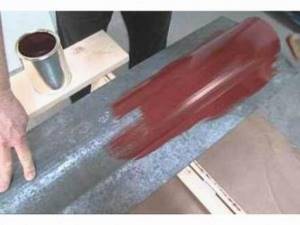
The use of specialized paint for galvanized pipes is not considered mandatory, since the steel is already protected by a zinc coating from the negative effects of atmospheric conditions. The protective layer protects the metal from contact with an aggressive external environment (oxygen and moisture), preventing its corrosion and extending the service life of products made from it.
Types of paints
Proper processing of galvanized steel is a prerequisite for long-term operation of the material. For this it is important to choose paint. The requirements are high levels of adhesion and elasticity.
Not all mixtures have similar properties. For example, oil compositions are not used for galvanizing. When they come into contact with metal, adhesion decreases, so over time the paint begins to peel off.
Acrylic
Such compositions are produced on the basis of appropriate resins and organic solvents. They contain special additives that protect sheet steel from corrosion. They are produced in different colors. After treatment, the surface acquires an attractive appearance.
Acrylic mixtures have a number of advantages:
- low cost;
- good adhesive properties;
- resistance to ultraviolet radiation, atmospheric moisture, precipitation (they do not fade even in direct sunlight, do not lose their properties, which is important when the compositions are used for roofing).
In addition, acrylic coatings are characterized by water-repellent properties.
Alkyd
This type of paint coating is standardly used in industry and regions with harsh climates. Alkyd mixtures are used to coat pipes and other galvanized structures. After drying, they form a strong and durable glossy coating.
The scope of application of alkyd mixtures is limited, since sometimes the mixtures react with the zinc layer, destroying it.

Vinyl enamels
- are highly resistant to adverse weather conditions;
- safe;
- are made on the basis of polymer compounds;
- form a durable layer;
- their characteristics are a bit like rubber.
The mixtures form a durable coating that can withstand mechanical stress and high temperatures. Vinyl paints have good adhesive properties and elasticity. They meet the requirements for such compositions. The only drawback is the high cost.
Tips for choosing
When choosing a particular paint, first of all, you should pay attention to the functions that the pipe will perform. If it is intended for cold drainage, it is more important to consider the anti-corrosion properties. For hot water pipes heat resistance. Storage periods must be normal, since after their expiration the composition of the paints begins to deteriorate.
approximate price
The exact cost of paint depends on many parameters, such as the manufacturer, packaging volume, place of purchase and other nuances. The table below shows approximate prices for paint:
| Type of paint | Price per kg, rub |
| Acrylic | 250-650 |
| Alkyd | 150-450 |
| Vinyl | 350-1000 |
Special coloring compounds
Special mixtures can also be used for galvanized surfaces. These include, for example, powder mixtures that polymerize when heated.
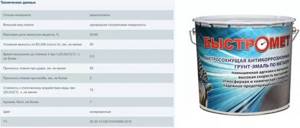
They include:
- fine polymer powders;
- special resins;
- pigments and additives to improve performance.
Powder mixtures are difficult to apply with your own hands - you need special equipment and work skills. Therefore, such compositions are more often used in industry.
Coating formed with powder paints:
- is resistant to alkalis, acids and petroleum products;
- differs in strength and hardness;
- meets the highest fire safety requirements.
For extreme conditions, special enamels can be used to treat surfaces that heat up to high temperatures - for example, Bystromet. There are fire-retardant mixtures (Polistil) and current-conducting compounds. They are also used in industry.
Compositions such as acrylic primers for galvanized surfaces are recommended. They have protective properties. In addition, they are used as a primer and paint at the same time.
Imported paints
The most popular imported brands for roofing are Tikkurila and Hammerite. Both brands produce compounds for processing galvanized metal that are suitable for outdoor use.
The products of both brands have the following advantages:
- good adhesion to metal;
- high degree of corrosion protection;
- the ability to form a strong, durable and wear-resistant coating;
- each brand has many colors in its signature palette;
- the color of the surface does not change even with prolonged exposure to sunlight.
Such coatings require careful preliminary surface preparation. If somewhere the degreasing is not done thoroughly enough, the paint will crack. Tikkurila produces an epoxy mixture that can also be used as a primer.
The paint is resistant to precipitation, high and low temperatures. You can apply the mixture yourself.
Domestic products
A popular mixture is “Cycrol”. This brand produces acrylic compositions that form a matte finish. Ethyl acetate or solvent are used as diluents. They produce paints in 5 basic shades.
These are the base colors:
- high adhesive properties;
- resistance to exposure to sunlight.
The characteristics of the compositions allow them to be applied in 1 layer. The adhesion is such that you can do without a primer. Paints can be used in a wide temperature range, so their application can be carried out in winter. At room temperature, the layer dries completely in 18 hours.
Compositions such as Nerzhalux enamels are recommended. The main advantage is high adhesive ability. It is based on acrylic copolymers (they provide corrosion resistance). Enamels are applied in 3 layers. This allows you to form a durable coating that will last at least 10 years.
